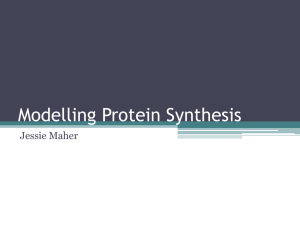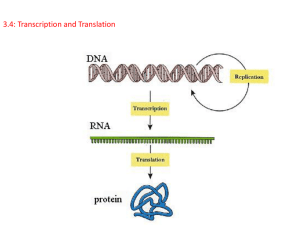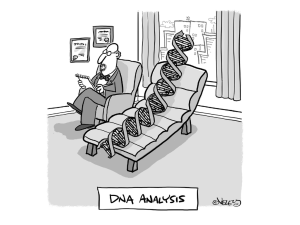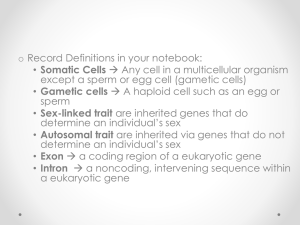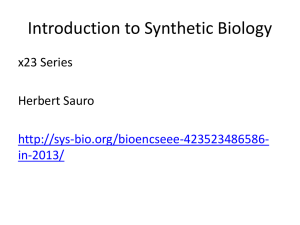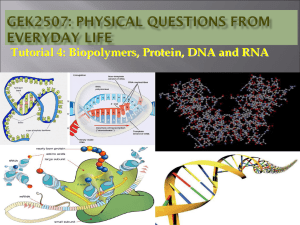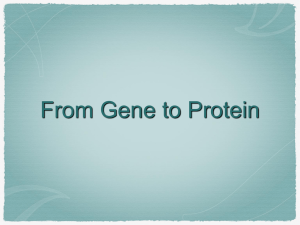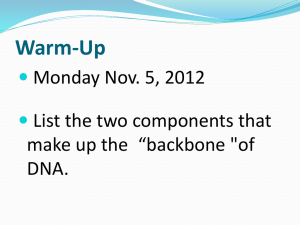Protein Synthesis Notes
advertisement
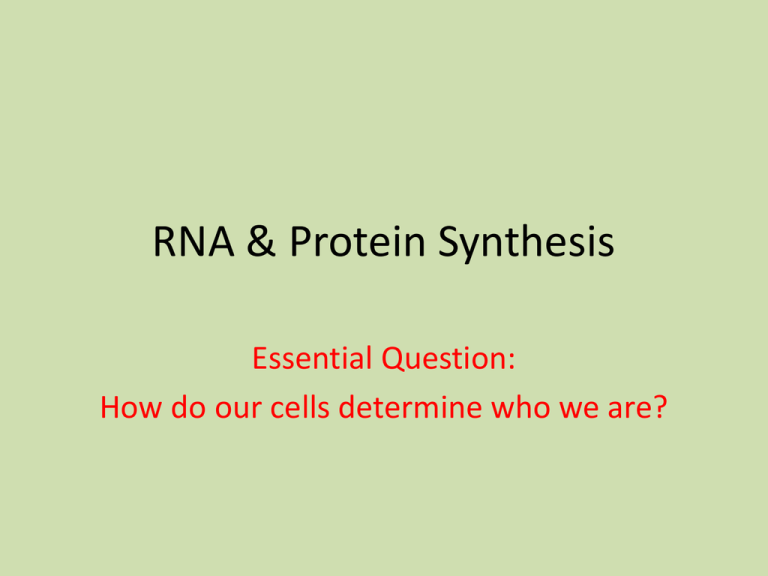
RNA & Protein Synthesis Essential Question: How do our cells determine who we are? Why are proteins important to living things? • • • • Control rate of chemical reactions as _e__________ nzymes Building materials for skin, bone, and _m_________ uscles ntibodies Help fight infections as _a__________________ Help control what goes in and out of cell through cell _m____________________ embranes 1. What is a gene? • Small section of DNA that holds code for making a particular protein, or for particular trait. 2. What is RNA? How is it different from DNA? • Ribonucleic acid. • DNA has two strands, RNA only has one. • RNA has U (uracil) instead of T (thymine). The other bases are the same (A, G, C). 3. What happens to DNA in the process of transcription? • DNA in nucleus is “unzipped.” A copy of one strand is made in the form of messenger RNA (mRNA) Adenine (DNA and RNA) Cystosine (DNA and RNA) Guanine(DNA and RNA) Thymine (DNA only) Uracil (RNA only) mRNA DNA 4. Proteins are made by joining ___________________ amino acids into long chains called polypeptides. Protein molecule 5. Each polypeptide contains a combination of how many different amino acids? 20 __________ 6. “Words” in the genetic code of DNA and RNA are 3 made up of how many bases? __________ 7. How are codons translated into different amino acids? • Codon made up of 3 nucleotide bases, e.g. AAG, CUA, etc. • Each set of 3 bases translates into different amino acid, e.g. AAG = lysine, leucine • CUA = _________ 8. What do “start” and “stop” codons do? • Start = beginning of polypeptide • Stop = end of polypeptide. • If protein = paragraph, polypeptide = sentence, amino acids = words. Quick Lab: How does a cell interpret DNA? 1. A certain gene has the following sequence of nucleotides: GACAAGTCCACAATC Write this sequence on your sheet of paper. 2. From left to right, write the sequence of the mRNA molecule transcribed from this gene: C UGUUC AGGUGUU AG Quick Lab: How does a cell interpret DNA? 3. Look at Figure 12-17. Reading the mRNA codons from left to right, write the amino acid sequence of the polypeptide translated from the mRNA. CUGUUCAGGUGUUAG • • • • • CUG = ______________ Leucine Phenyl-alanine UUC = ______________ Arginine AGG = ______________ UGU = ______________ Cysteine Stop UAG = ______________ Quick Lab: How does a cell interpret DNA? 4. Repeat step 3, reading the codons from right to left. CUGUUCAGGUGUUAG • • • • • Aspartic acid GAU = ______________ Cysteine UGU = ______________ GGA = ______________ Glycine Leucine CUU = ______________ GUC = ______________ Valine Analyze and Conclude 1. Why did steps 3 and 4 produce different polypeptides? Reading bases from left to right produces different codons from reading right to left. Analyze and Conclude 2. Do cells usually decode nucleotides in one direction only or in either direction? Usually one direction only 9. What happens to messenger RNA (mRNA) in the process of translation? • mRNA is translated into chains of amino acids that form proteins. 9. What happens to messenger RNA (mRNA) in the process of translation? • mRNA is translated into chains of amino acids that form proteins. 10. Explain the role of the following in protein synthesis: a. gene Contains code for making a protein 10. Explain the role of the following in protein synthesis: b. mRNA Copy of gene that can be taken out of nucleus into cytoplasm. Adenine (DNA and RNA) Cystosine (DNA and RNA) Guanine(DNA and RNA) Thymine (DNA only) Uracil (RNA only) mRNA DNA 10. Explain the role of the following in protein synthesis: c. tRNA Transfers amino acids over to mRNA, where they can be joined together to form protein. 10. Explain the role of the following in protein synthesis: d. codon 3-letters/bases on mRNA that holds code for 1 amino acid 10. Explain the role of the following in protein synthesis: e. anticodon 3 letters/bases on tRNA that match with codon on mRNA anticodon codon 10. Explain the role of the following in protein synthesis: f. ribosome Helps join amino acids together to form protein/polypeptide ribosome 10. Explain the role of the following in protein synthesis: g. amino acid Molecules that join together to form protein Protein molecule Video: Protein Synthesis http://www.youtube.com/watch?v=D3fOXt4MrOM Pop Quiz: Copy the codons below and identify the corresponding amino acids. p. 303 1. 2. 3. 4. 5. GCU = __________ alanine CAA = __________ glutamine UGG = __________ tryptophan AUG = __________ methionine histidine CAU = __________ Your name at bottom



